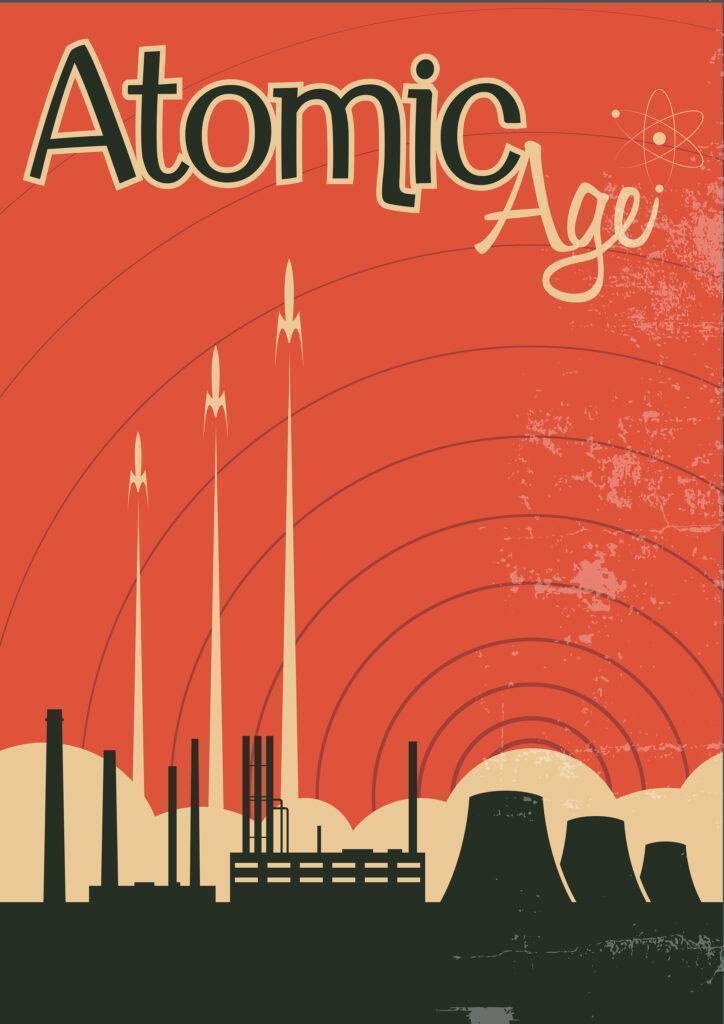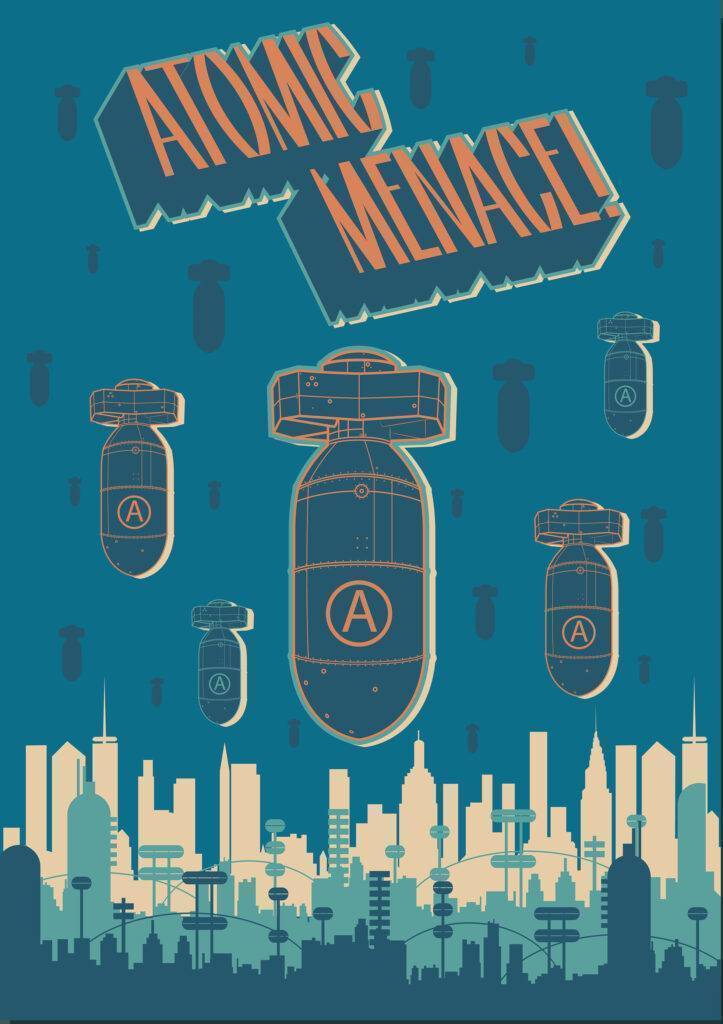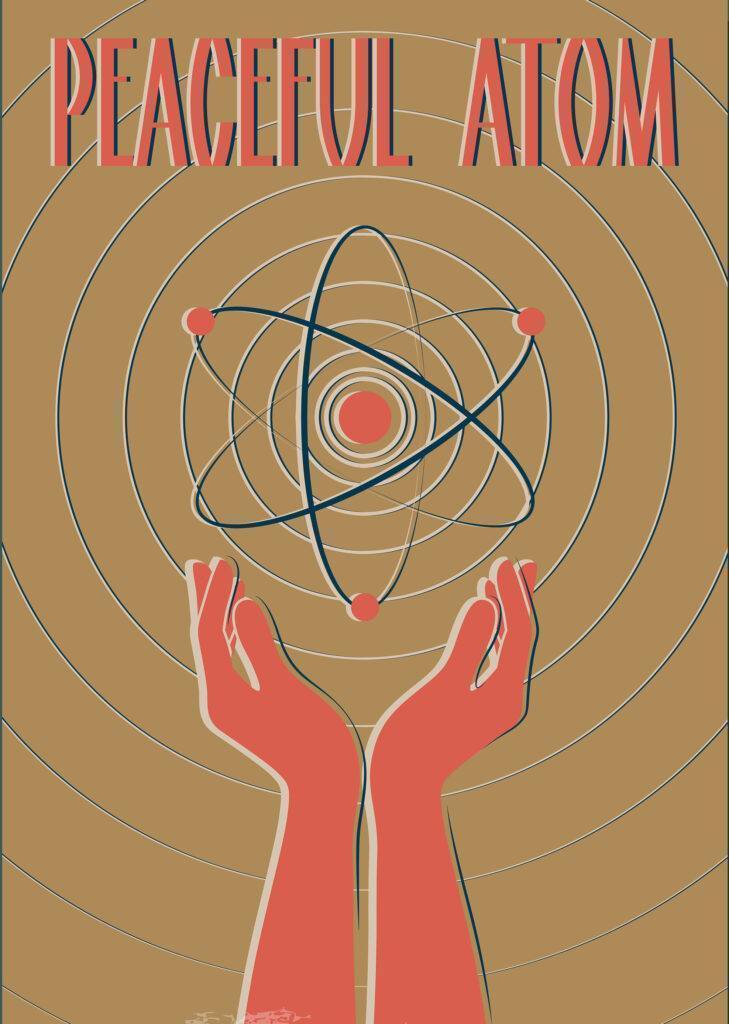Is it the low-carbon answer to keeping our lights on?
We can thank nuclear fusion for the sun and the stars, and here on earth, nuclear fission gives us a zero-carbon energy source. But nuclear’s magic can be dark — there are radioactive waste, weapons, and accidents. Despite those risks, does our urgent need to reduce carbon make nuclear energy our best bet right now?
In late March 2020, while Eastern Massachusetts — indeed the world — began tracking COVID numbers and fearing trips to the grocery store, the dismantling of Plymouth’s Pilgrim Nuclear Power Station, decommissioned in 2019, continued on schedule.
Dismantling a nuclear power plant is no simple feat, due primarily to its radioactive waste. As Rich Salzberg reported for The MV Times, “Pilgrim has 1,156 fuel rods in 17 dry storage casks. These are giant stainless steel cylinders nested in giant concrete cylinders. In the plant’s spent fuel pool, there are 2,958 fuel rods.”
Many applauded the decommissioning of Pilgrim, and hope to see the remaining 55 commercially operating nuclear power plants in the U.S. follow suit. They insist that nuclear energy is too dangerous; that waste disposal is too massive and long-term a problem; that the materials necessary for nuclear energy could fall into the hands of terrorists or a rogue government. Sure, nuclear energy might have been a necessary evil, they say, but now we have affordable solar. We have wind.
Others, however, argue that to achieve the necessary low-carbon energy future we require, the U.S. doesn’t have time to wait for renewables to scale up; that renewables require too much land; that their energy output can be sporadic. That nuclear isn’t the answer, but it’s a key part of it. And that the cons of nuclear energy — the radioactive waste, accidents, plutonium falling into the wrong hands — are exaggerated. While they don’t dismiss the risks that nuclear poses, they argue that the need for rapid-scale decarbonization makes the risks worth it.
But are the risks worth it? And is this debate moot, given the rising costs of nuclear reactors versus the plummeting costs of wind and solar? Is investing in nuclear power another way governments and industry delay acting on climate change, as some critics accuse?
Given that Biden’s climate adviser, Gina McCarthy, according to an April 1 Bloomberg article, said that nuclear energy should be one of the power sources eligible for a national clean energy mandate via the Build Back Better plan, it’s clear the conversation is far from over.
How does nuclear energy work?
Put simply, when atoms are split — a process called fission — a tremendous amount of energy is released. Uranium and its resulting byproduct, plutonium, are the most common elements in nuclear power reactors. The energy released heats water into steam, which in turn spins turbines to produce electricity. Paul Hawken, author of Regeneration: Ending the Climate Crisis in One Generation, has called it “the most absurd way humanity has ever invented to boil water.” Historically and almost universally, we’ve relied on coal or gas to do the same thing. But where coal and gas emit greenhouse gases, nuclear emits far less — 10 to 100 times less than coal, for instance.
“I see [nuclear energy] as an essential tool,” says Jacopo Buongiorno, TEPCO Professor of Nuclear Science and Engineering, and director of the Center for Advanced Nuclear Energy Systems at the Massachusetts Institute of Technology (MIT). Buongiorno points to nuclear’s ability to produce energy on demand, to be compact and carbon-free. He calls it part of a “balanced portfolio of technologies.” Which is why, he believes, “we have very solid bipartisan support in Congress for nuclear.”
Dr. Sweta Chakraborty, a risk and behavioral scientist, agrees with Buongiorno, calling nuclear “the only carbon-free energy source that can deliver electricity 24/7/365,” and noting that it already supplies more than half of the carbon-free electricity in the U.S., though renewables play a necessary and key role too, she says.
But what about the cost?
Nuclear plants are “prohibitively expensive,” says a 2021 report from the Union of Concerned Scientists (UCS) titled “‘Advanced’ Isn’t Always Better,” noting the expense makes it unappealing to private investment and fuels public skepticism of nuclear as a viable option.
Ellie Johnston, climate and energy lead with Climate Interactive, a not-for-profit think tank that grew out of MIT Sloan School of Management, and that models the impacts of climate change, sees nuclear as part of the mix, “but we see renewable energy growing much, much more. And one of the big reasons for that just comes down to the economics of it. Solar and wind costs have been falling precipitously in the past decade-plus. And when we look at nuclear, that’s not the story at all.”
Buongiorno concedes that cost has been an impediment to nuclear’s growth. Projects in the U.S. and Western Europe, he says, have had cost overruns and schedule delays. “These are complex machines,” he reminds us. Consequently, “we need a change,” he says. “And the change is a change in technology toward … small modular reactors, or micro reactors.”
Say what?
The field of nuclear energy is abuzz with, as Buongiorno noted, micro reactors and small modular reactors, or SMRs. The two, while both considerably smaller than a traditional nuclear reactor, have different outputs. “Recently I have seen … less than 20 MW is [a] micro reactor, above 20 MW is a SMR,” explains Buongiorno. Put another way, an SMR could power a city, while a micro reactor could power a large factory or a community.
“You crank [micro reactors] out of a factory a little bit like you would do with cars,” he says, citing his own excitement at the prospect, then you “load them on the back of a truck, and … you get to a site, and that’s your power plant.” These micro reactors would be portable, requiring no onsite construction (which could reduce or eliminate the cost overruns and schedule delays that plague larger nuclear projects), power can be built up in smaller increments, which would reduce capital risk, and, he says, many projects don’t need the energy output of larger reactors.
There’s considerable excitement around these micro-reactors, including right here on the Vineyard.
Norman Foster, an architect focused on high-tech, and a key figure in the modernist movement, who lives part-time on the Vineyard, has been working with Buongiorno. Foster believes we’re moving toward a revolution in nuclear power. “Imagine a 20-foot-long container housing a micro reactor, which when attached to a similar-size generator, could power a small town, or be plugged in to energize a city block,” he described to Bluedot Living in an email. “Another module could convert seawater to jet fuel, and the process would help to deacidify the oceans. Similar units could desalinize seawater.”
These smaller, sealed units, he wrote, would be safe and maintenance-free. The fuel module would be replaced every five to seven years, and the uranium fuel is non-weapons-grade.
SMRs are also on the horizon, the design product of NuScale, an Oregon-based company, with a $300 million investment from the U.S. Department of Energy. SMRs can be also built more quickly and cheaply than traditional nuclear plants, although costs are significant compared with renewable energy sources, and even natural gas. While no SMRs are yet constructed, several are close to completion in Argentina, China, and Russia, according to a Scientific American story, and many more are under consideration around the world.
Sounds promising! So what’s the problem?
As always, with nuclear energy, the two as-yet-unresolved issues are nuclear waste disposal and safety. The 2021 UCS report notes that even with considerable interest in nuclear energy, growth has stagnated due, in part, to a chilling effect from the 2011 accident in Fukushima, Japan. It cites the current rate of construction of new nuclear plants around the world as only barely outpacing the retirements of existing plants, such as Pilgrim. The report goes on to say that “nuclear reactors and their associated facilities for fuel production and waste handling are vulnerable to catastrophic accidents and sabotage, and they can be misused to produce materials for nuclear weapons.” UCS calls on the industry, policymakers, investors, and regulators to address these concerns fully before expanding any nuclear energy projects.
Dr. Ken Buesseler, senior scientist at the Woods Hole Oceanographic Institution (WHOI) and an expert in radioactivity in oceans, has seen the damage from the Fukushima Daiichi Nuclear Power Plant accident up close. “When things go wrong, they can go very wrong,” he says. And while the nuclear industry likes to point out that there have been fewer than a handful of accidents, Buesseler isn’t so comforted. “If you think of three reactors in Japan, [plus] Three Mile Island and Chernobyl, you can say, ‘Look, five reactors had fatal accidents and meltdowns over something on the order of 450 commercial reactors over time.’ But you know, five out of 450 … you wouldn’t fly a plane if the odds were that bad.” Of course, he says, lessons have been learned. For instance, it’s highly unlikely that a reactor will now be built in a tsunami-prone area. But climate change, he notes, is creating profound changes to the planet, including to sea level rise. A safe site today mightn’t be so safe down the road. “No energy is independent of its consequences,” he says.
Norman Foster believes we’re moving toward a revolution in nuclear power: “Imagine a 20-foot-long container housing a micro reactor, which when attached to a similar- size generator, could power a small town or be plugged in to energize a city block. Another module could convert seawater to jet fuel, and the process would help to deacidify the oceans. Similar units could desalinize seawater.”
To address these legitimate safety concerns, says Chakraborty, “up-and-coming advanced reactor designs also feature significant safety features — for example, with smart systems that will turn themselves off if any measurements change unexpectedly, without waiting for human intervention.”
Still, says Buesseler, “we have a nuclear waste issue that we’ve never dealt with satisfactorily.” Take Pilgrim, for instance. “That nuclear waste is going to sit in storage pools essentially until forever, or until they come up with someplace where they can collect it and store it in a safer manner.” He compares it to producers of fossil fuels not caring about its byproduct, carbon dioxide. And look where that’s got us.
But Chakraborty suggests that concerns about waste are overblown. All the spent fuel used in the U.S. over the past 60 years only takes up one football field, 10 yards deep, she says. She raises another point, too: “Having a strong nuclear sector allows the U.S. to play a role in international rulemaking on how and which nuclear materials are developed.” Last year, she says, 38 national security experts wrote to Congress to argue that maintaining U.S. nuclear expertise and exporting new, U.S.-developed nuclear technologies is crucial to nonproliferation and national security over the long term.
Further, those urging the development and adoption of micro reactors, such as Buongiorno and Foster, point to how rapidly our energy requirements are growing. We don’t have the luxury of ignoring nuclear’s potential, they say, because, with the escalation in electric vehicles, as well as population growth, and, of course, the deepening climate crisis, only nuclear energy can meet this demand quickly and cleanly.
Just do the math, urges Foster. “The current rate of carbon dioxide, the principal greenhouse gas, being spewed into the atmosphere is 36 billion tons per year, over 20 percent of which is created by the production of energy,” he says. “The reality is that … only 2.1 percent of the world’s electricity is produced by solar, which is weather- and battery-dependent. Perhaps more strikingly, the world is dependent on fossil fuels for around 64 percent of its electricity needs — with all the knock-on effects of atmospheric pollution.”
Foster goes further to make a moral argument. “Societies which are deprived of [energy] suffer higher rates of infant mortality, lower life expectancy, less sexual and political freedom, and are more likely to be experiencing war or violence,” he says.
What’s this about fusion?

It’s fission — the splitting of larger atoms — that produces the nuclear energy we use now. But there’s growing excitement about fusion, which produces massive amounts of energy by doing the opposite — combining smaller atoms to create large ones. It’s fusion that gives us the sun and the stars and, well, us. Like fission, fusion doesn’t produce carbon, but unlike fission, there is no radioactive waste, because the fuel it requires — two types of hydrogen — lasts for many thousands of years. What’s more, there is no chance of a meltdown.
Of course, where there’s promise, there’s investment, and some heavy hitters, including Jeff Bezos, are putting their money behind some fusion projects.
“For the first time in decades, there are serious breakthroughs that might make commercial fusion possible … in fewer than 15 years,” says Buongiorno. Fusion is similar to fission in many positive ways, he says. It’s carbon-free, dispatchable, has a low footprint, produces even less waste than fission, there’s broad availability of fuel (water), and, he says, “the physics of fusion eliminate certain safety concerns of fission, such as runaway reaction [like what happened at Chernobyl] and decay heat.”
However …
Even with so much innovation and investment in nuclear energy, it’s a tough sell. Vineyarder Jorie Graham has made it something of a mission to better understand the potential of this coming generation of nuclear reactors. As a poet, she recognizes the power of language, and thinks that part of the problem with nuclear energy is public perception. Indeed, a doctor recommending an MRI barely gives us pause (its acronym used to be NMRI, for nuclear magnetic resonance imaging — nuclear was dropped because of its negative connotations). But a mention of nuclear energy sends the thoughts of many of us straight to meltdown. Graham is not alone in thinking nuclear energy suffers from a messaging problem, which is why, increasingly, we’re hearing references to “quantum reactors.”
Whether security and safety concerns are warranted — and Ann Berwick, former Massachusetts Undersecretary for Energy, thinks they’re not — nuclear needs to be taken off the table in New England, she says. While she, personally, is a supporter of nuclear energy — “nuclear is bad, but climate change is worse,” she says — there’s far too much opposition to it in the Northeast, though it’s a different picture in various other parts of the country. In New England, “It’s not a conversation worth spending time on,” she says. “I can tell you that the chances of getting [nuclear] sited in Massachusetts are close to zero.” Rather, she thinks the focus should remain, primarily, on wind energy. “I would say there’s no way in New England to address a clean energy future without offshore wind.”
So … where does that leave us?

“There is no such thing as perfect technology,” says MIT’s Buongiorno. Renewable energy, which has a whole lot going for it, nonetheless can’t offer a constant and predictable supply of energy. And, while battery storage is improving in terms of capacity and cost, “the system becomes so large and so interconnected that it requires big transmission lines,” which boost cost and vulnerability should the lines become severed due to weather, or terrorism. And Buongiorno points to the vast land use required by renewable energy.
With discussion of pros and cons feeling like a game of nuclear football, perhaps the folks at Project Drawdown, which analyzed and compiled the top 100 solutions to climate change, put it most clearly, calling it one of the only “regrets” solutions they proposed. “Nuclear is a regrets solution,” they write, “and regrets have already occurred at Chernobyl, Three Mile Island, Rocky Flats, Kyshtym, Browns Ferry, Idaho Falls, Mihama, Lucens, Fukushima Daiichi, Tokaimura, Marcoule, Windscale, Bohunice, and Church Rock. Regrets include tritium releases, abandoned uranium mines, mine tailings pollution, spent nuclear waste disposal, illicit plutonium trafficking, thefts of fissile material, destruction of aquatic organisms sucked into cooling systems, and the need to heavily guard nuclear waste for hundreds of thousands of years.” Nonetheless, they conclude, it is, indeed, a solution.




